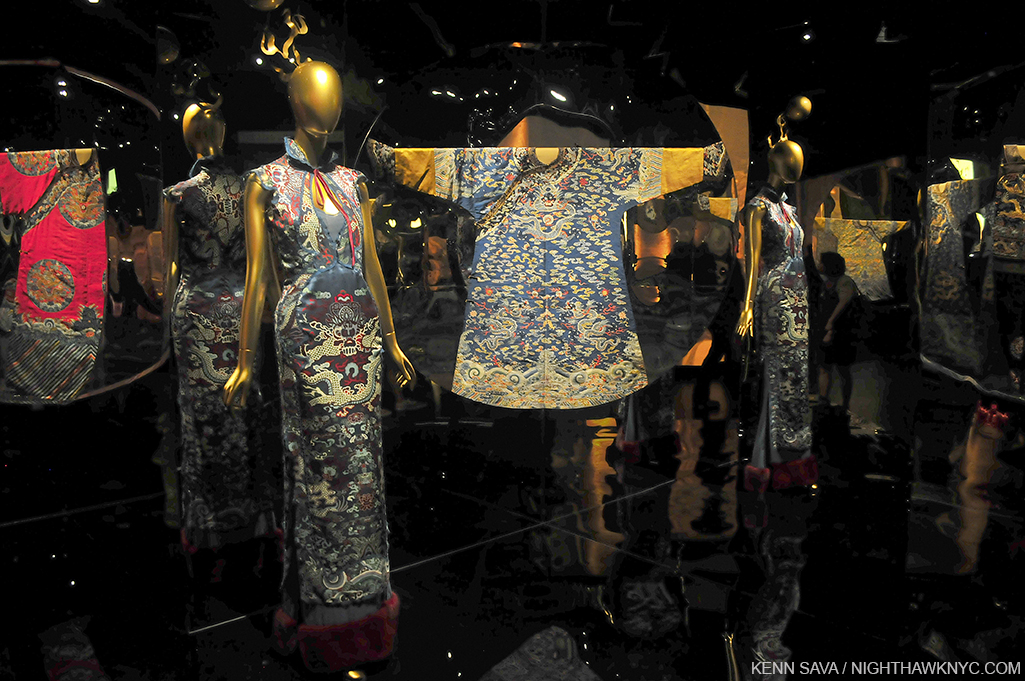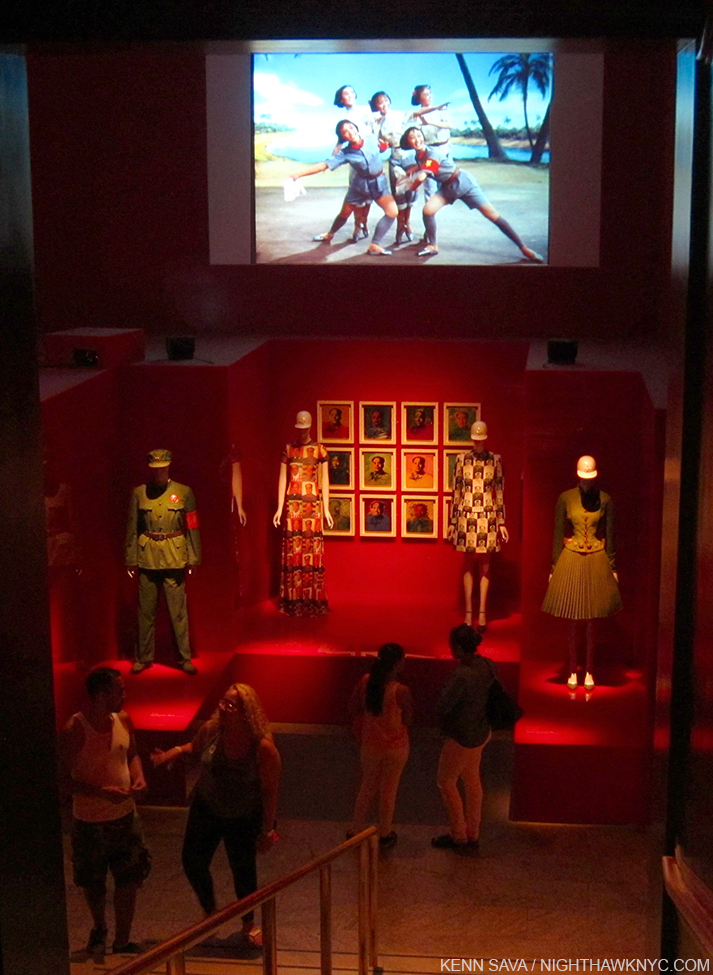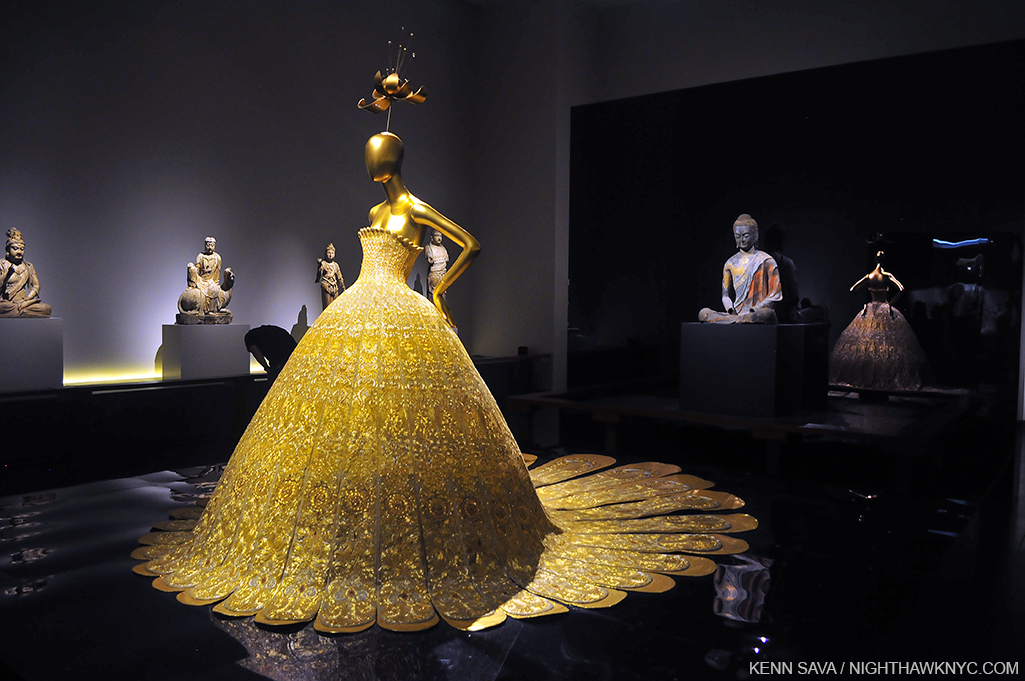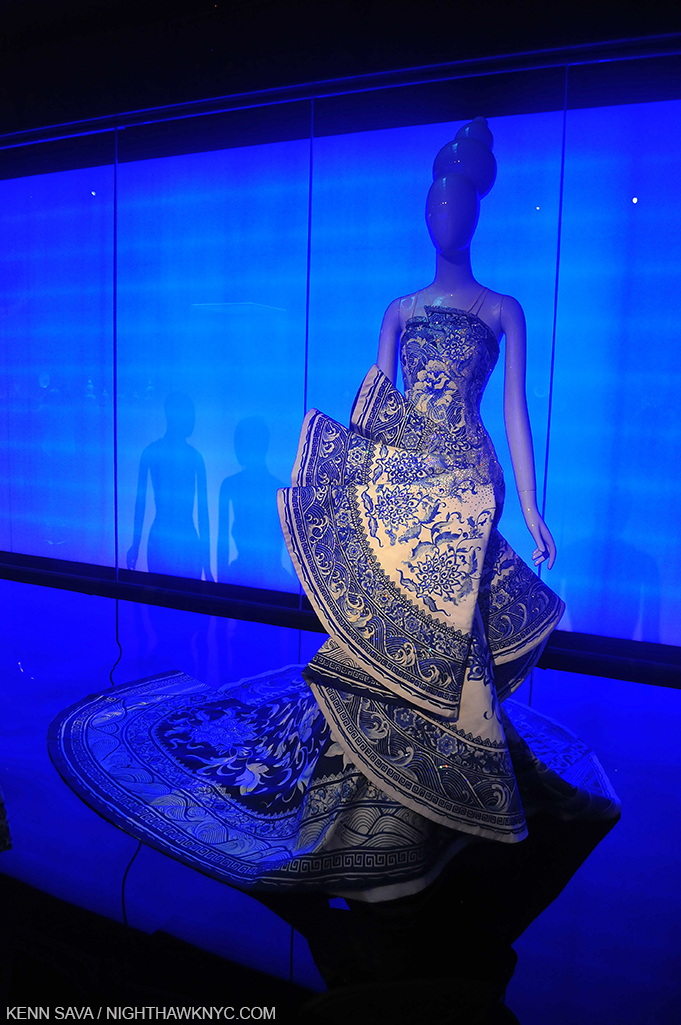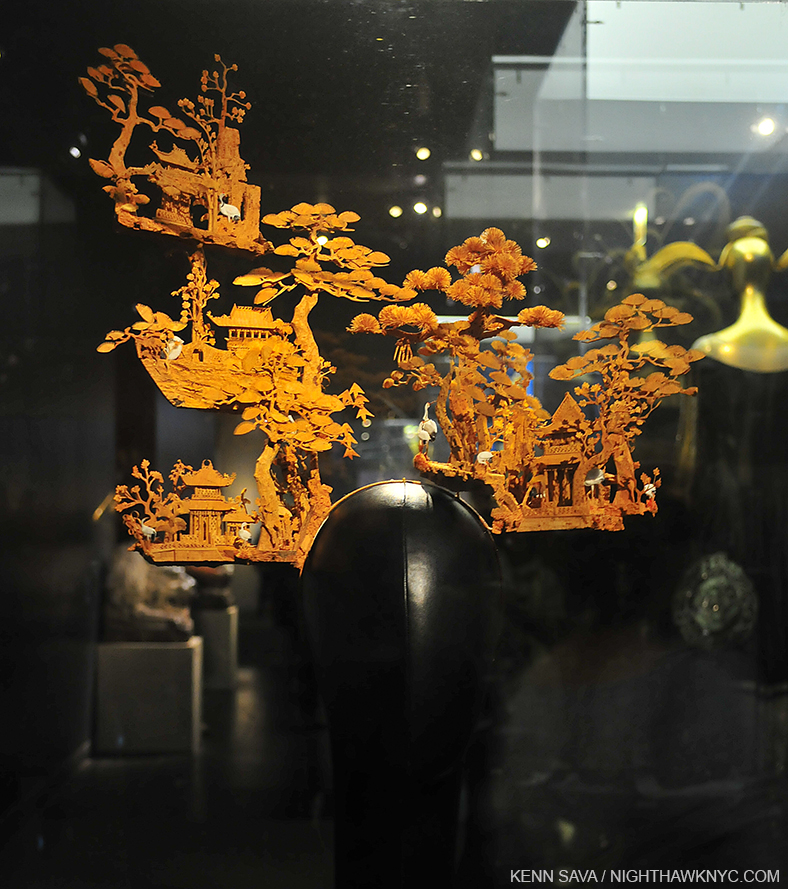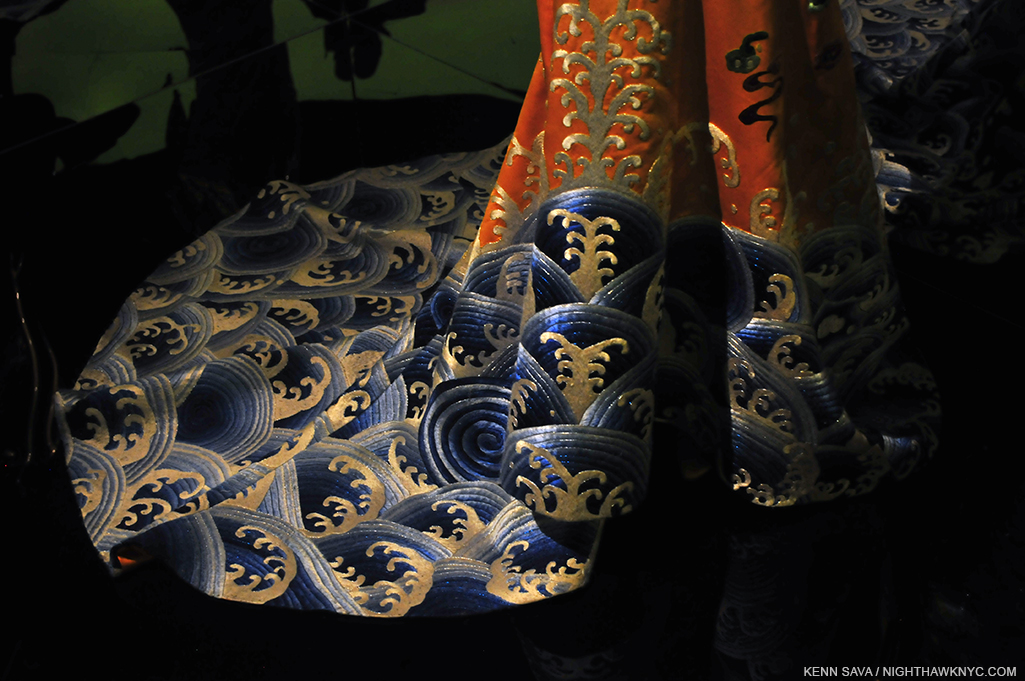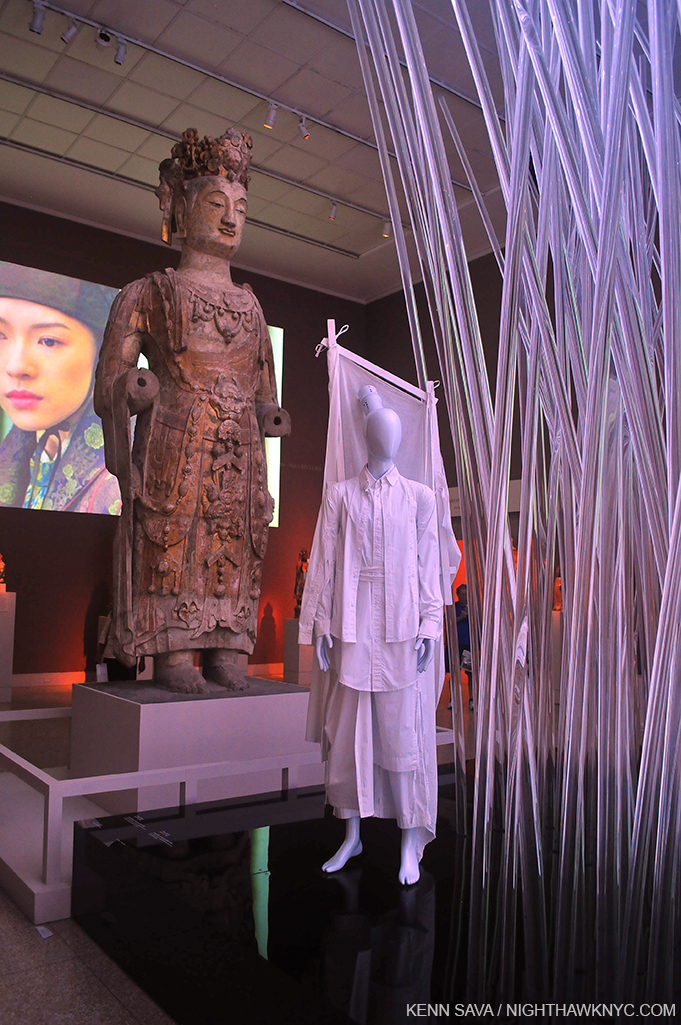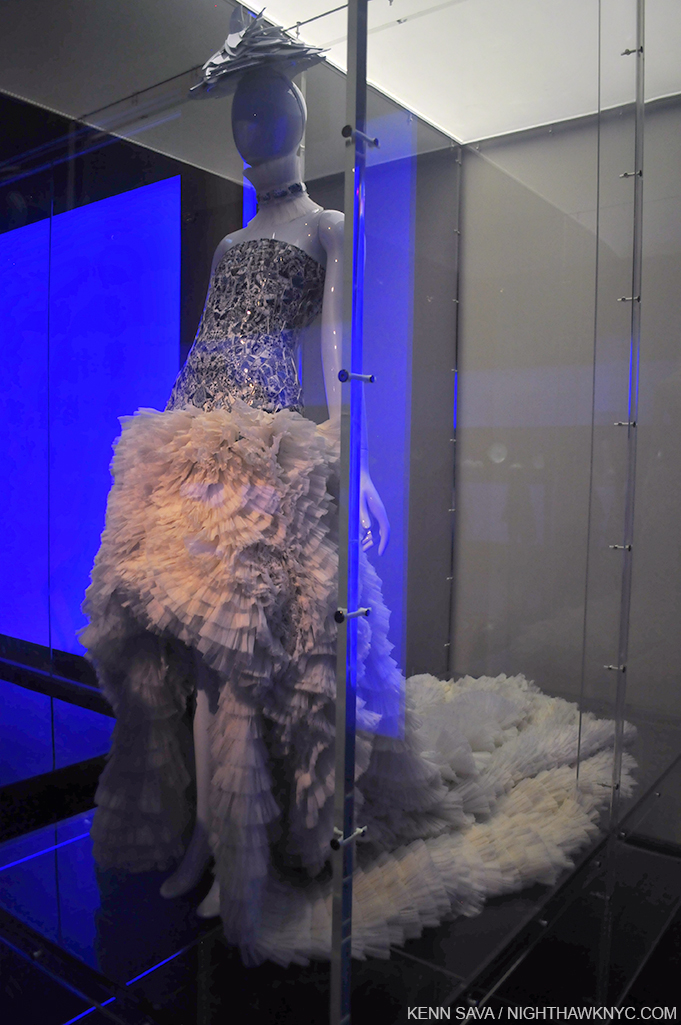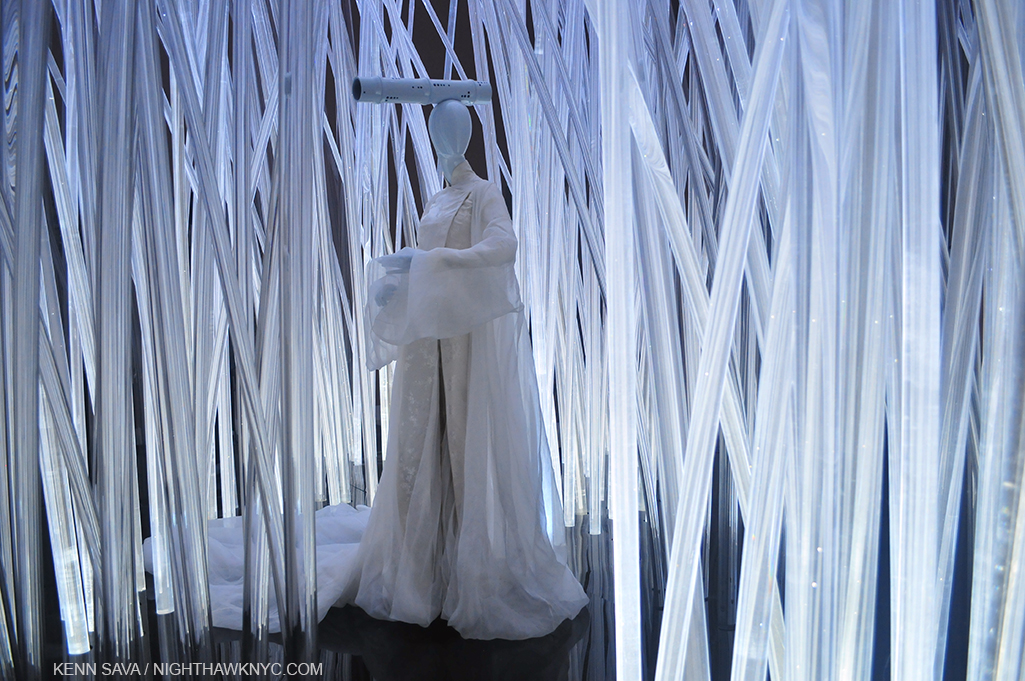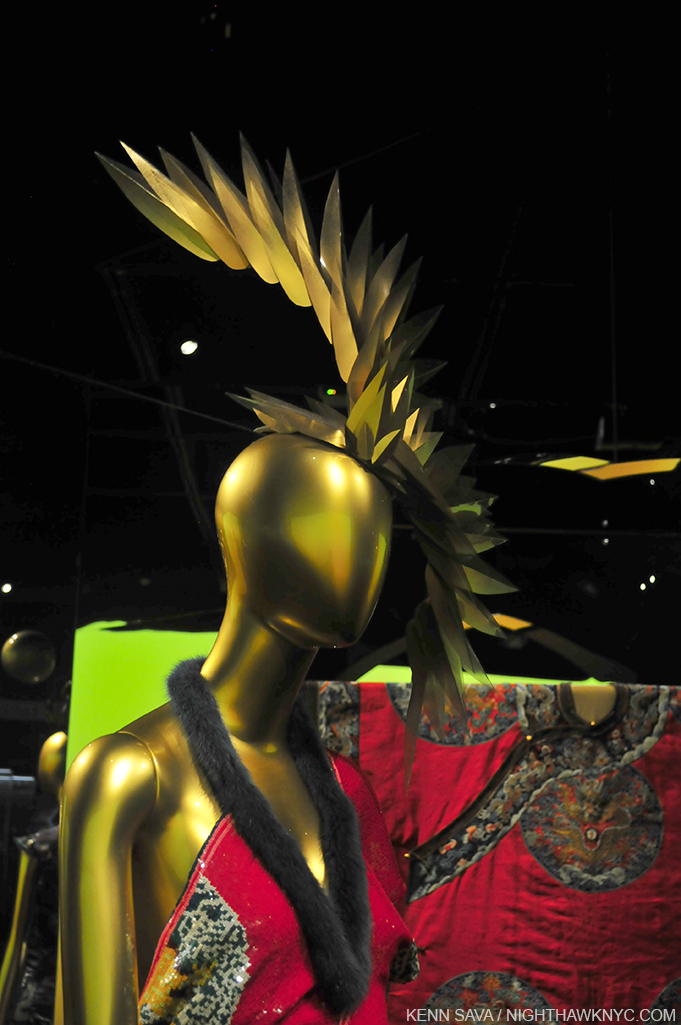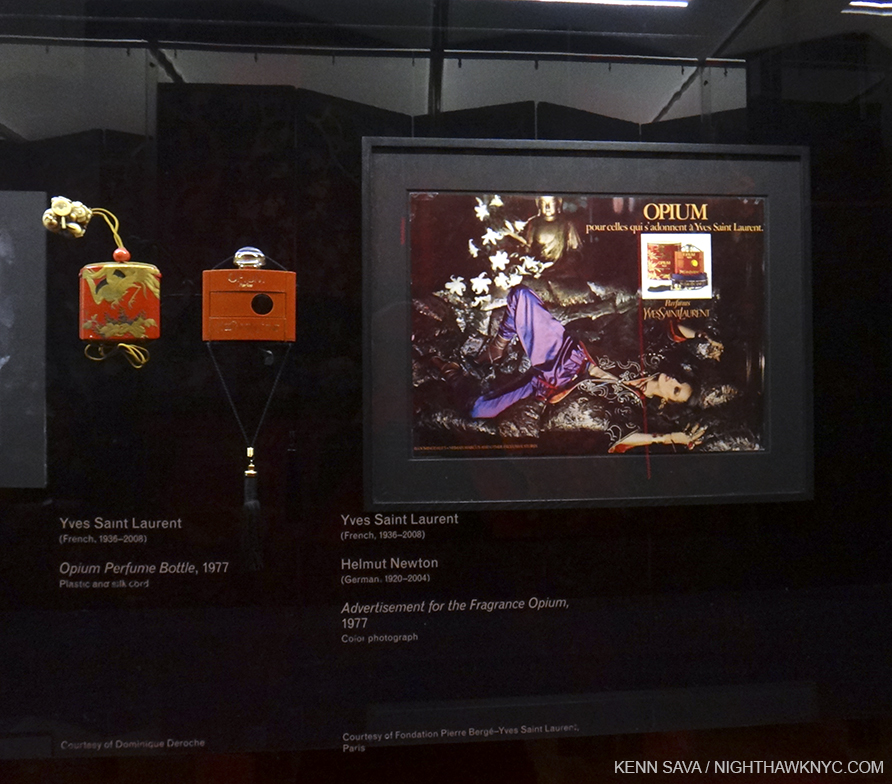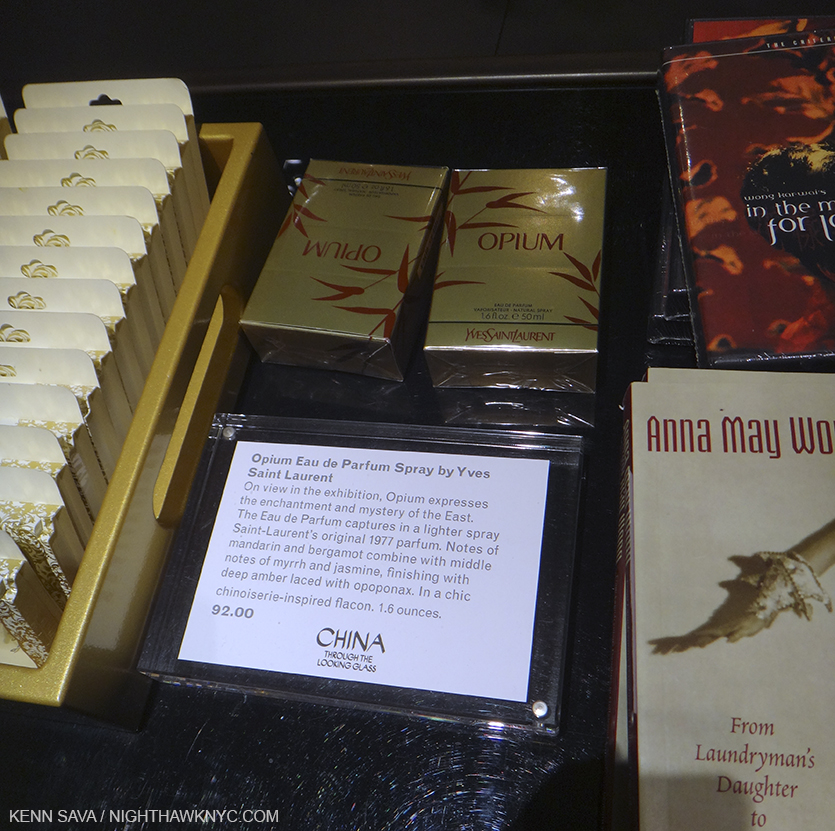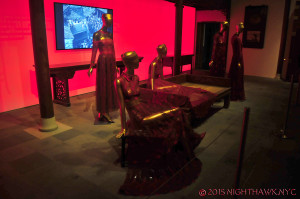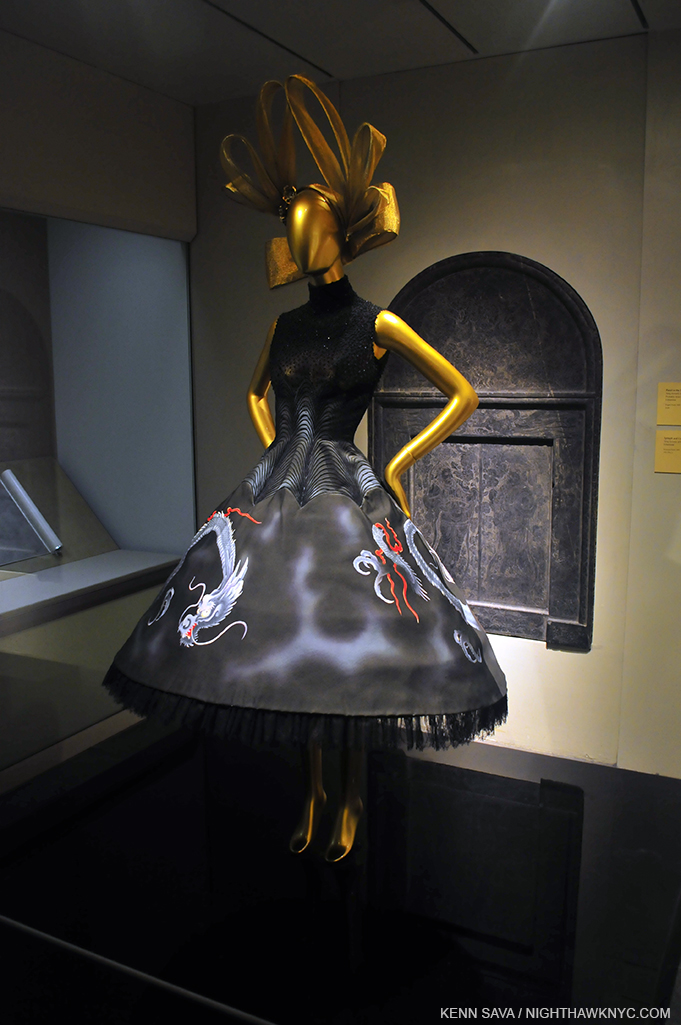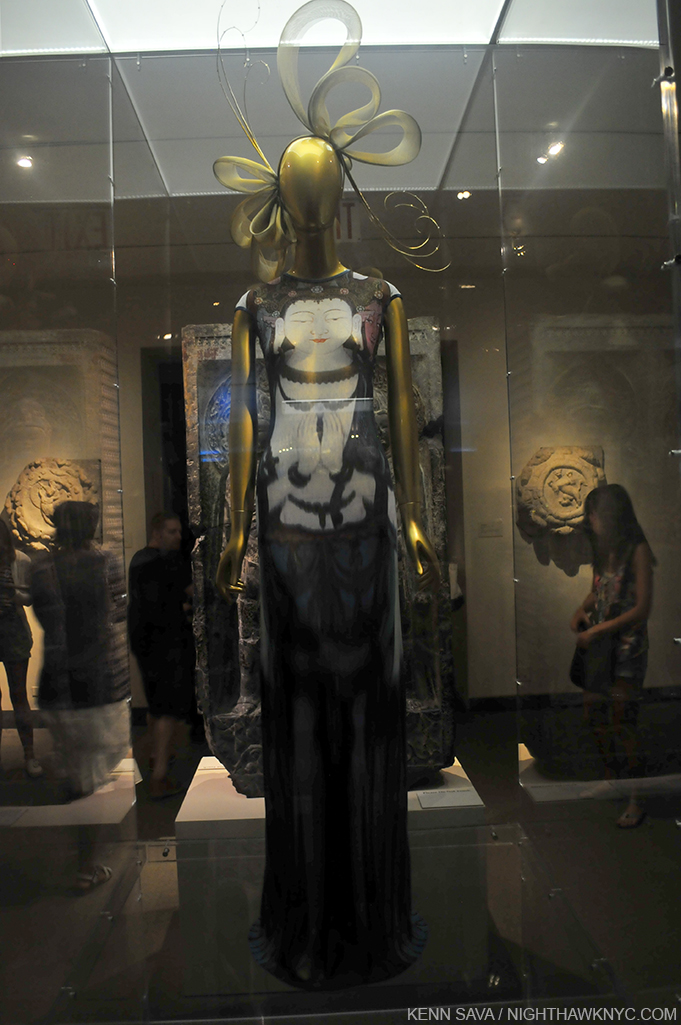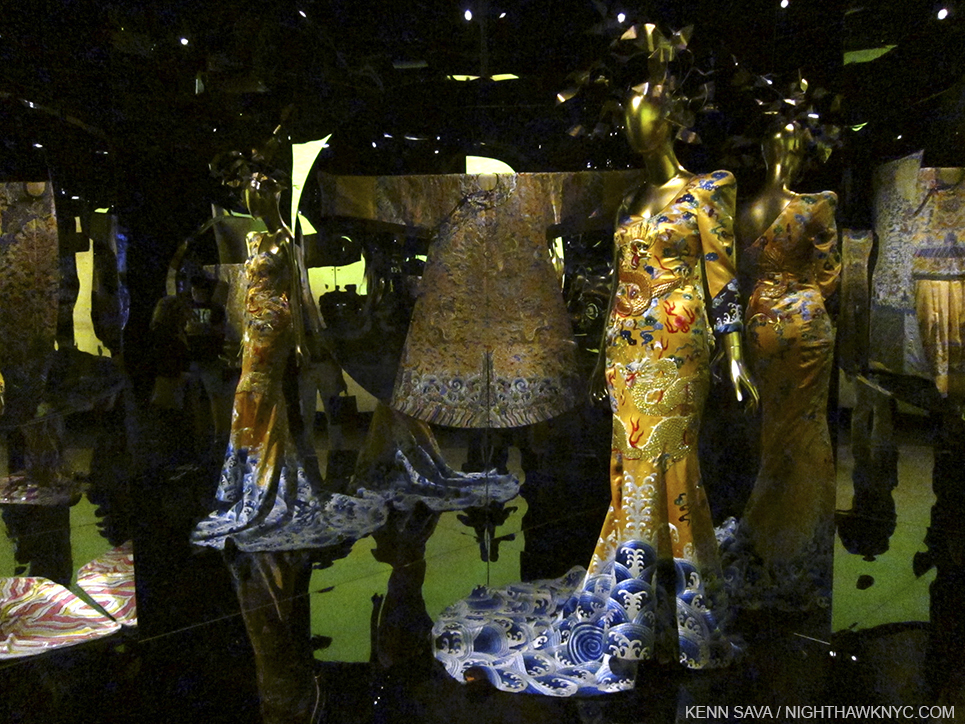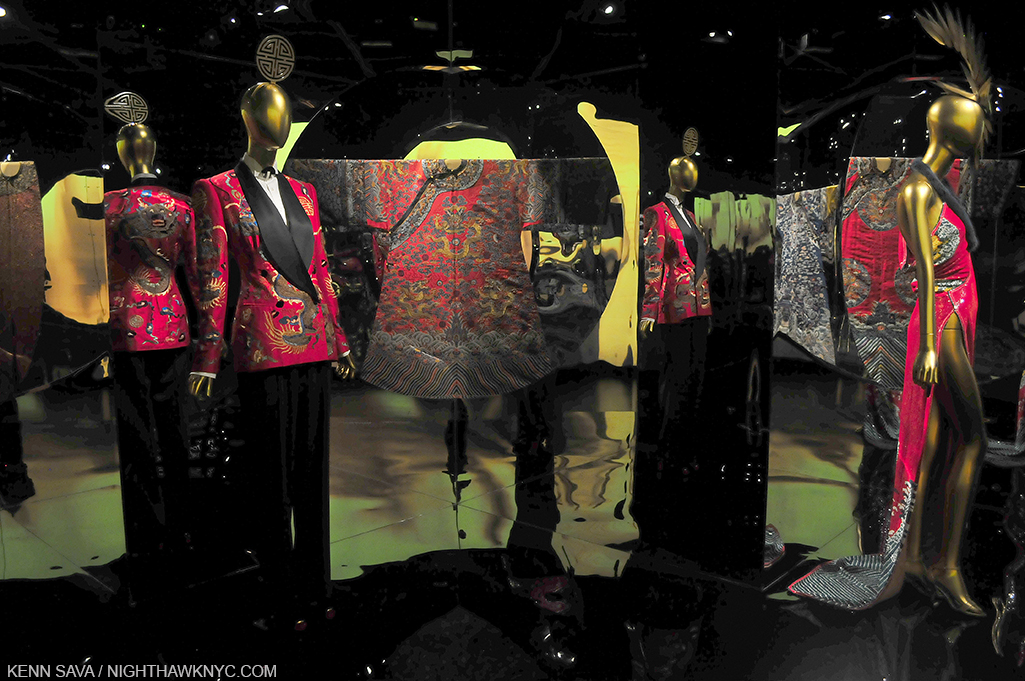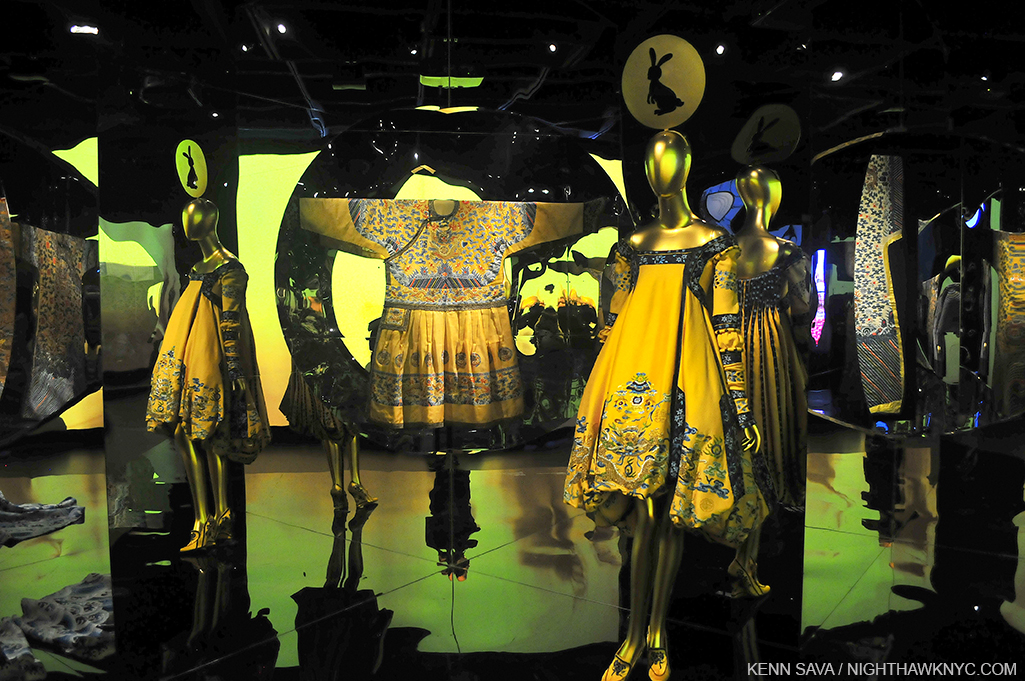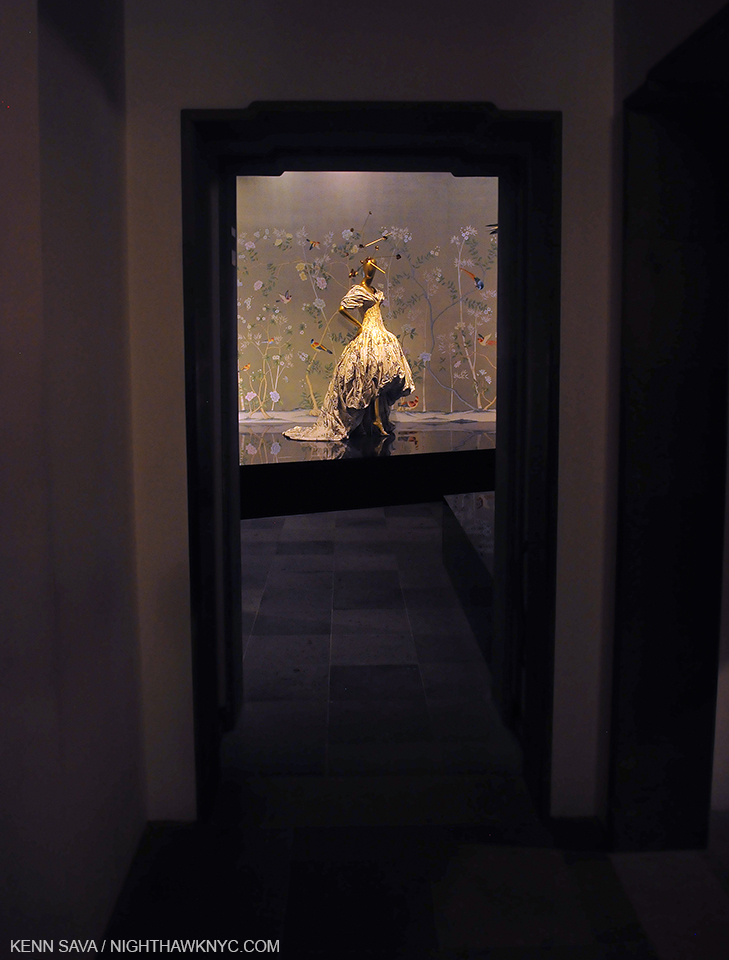This site is Free & Ad-Free! If you find this piece worthwhile, please donate via PayPal to support it & independent Art writing. You can also support it by buying Art & books! Details at the end. Thank you.
Written & Photographed by Kenn Sava
China: Through The Looking Glass is finally over, and now I can look back on it. Extended an additional 3 weeks through Labor Day, it went out with a bang like those heard on Chinese New Year. Like New Year’s Eve, The Met was open until Midnight on Friday and Saturday, September 4 & 5. Of course, the Nighthawk was there. Of course, he had to mention to staff members what a great idea being open to Midnight was, one that should immediately be adopted 7/365! A bit to my surprise the show was quite crowded even late Saturday night. Maybe those visitors agree.
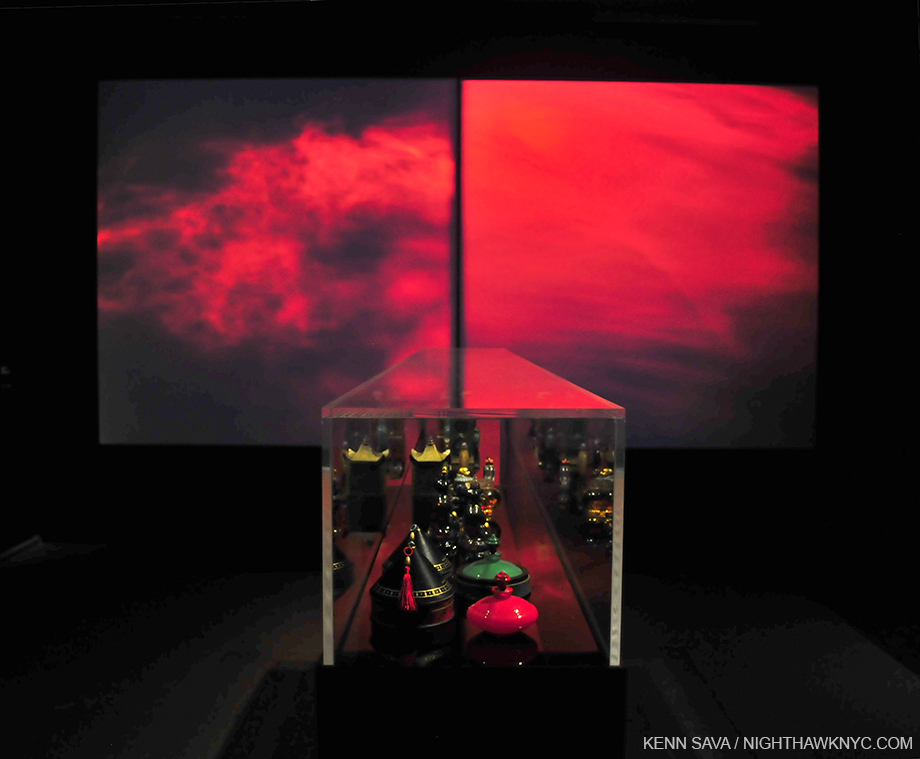
The Perfume Gallery featured 2 unsynchronized video screens, behind a selection of antique bottles. that evoked the visual essence of fragrance.
Wandering the galleries for the fifth and final time, I started to focus on the “other” big question, besides midnight hours for The Met- China: Through The Looking Glass drew about 814,000 visitors 1. The hugely popular Alexander McQueen: Savage Beauty drew 661,500 2. This show drew over 150,000 more!!! As I said, I’m not going to compare them. The McQueen had a shorter run, and The Met was only open 6 days a week back then.
Still, no matter how you slice it, the turnout was was astounding and unexpected-
How to explain the overwhelming success of this show?
Before getting to that, since I am replacing my previous brief post about the show with this one, some overall thoughts. China: Through The Looking Glass (or, C:TTLG) was a winner on every count, one of the best big shows in NYC in 2015 (I’m not going to say, “the best.” Comparing Artists, Art, shows, Films, Music or anything creative, or athletes for that matter, serves no purpose.) C:TTLG was that rare spectacle that illuminates.
It casts light on how the west fantasizes China, Chinese fashion, and Chinese culture and Art (how it fantasizes Chinese women, briefly touched on through Anna May Wong, is too complex for this show, or any other), while showing us the difference between how western designers have mirrored Chinese fashion, out of context & tradition, of course, to suit their own purposes, and the possible influences of particular antique items, superbly selected and displayed, often side-by-side, using mirrors in differing ways as the show moves along.
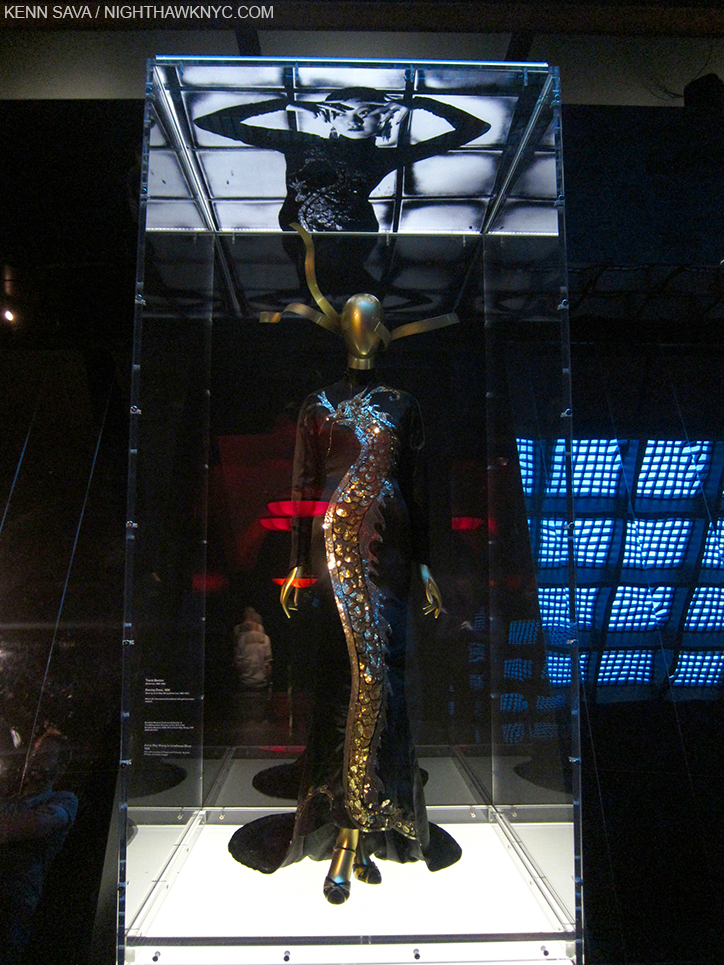
“These Foolish Things (Remind Me Of You)…” plays as Anna May Wong looks down on the very gown she’s immortalizing.
On both sides of the mirror the colors will pop your eyes right out of your skull, a miraculous thing for very old garments, which hold every bit of their own no matter what they are shown with, even Alexander McQueen (represented by at least 4 ensembles I saw, and a pair of Chopines), and this impact was spectacularly enhanced by yet another ground breaking Costume Institute installation (something I’ve admired about every one of their shows I’ve seen) and every element of it- the mirrors, the “mood lighting,” the extensive use of music and video.
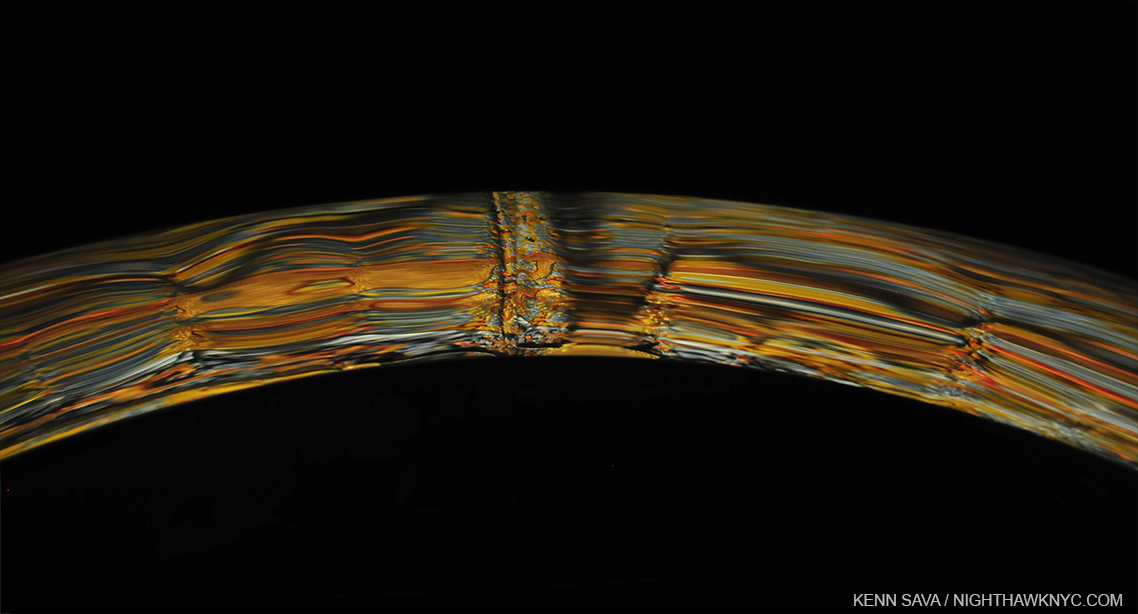
A close up of one of the countless mirrors on display, this one used to frame a brilliantly colored antique garment.
It seems they pulled out the stops this year, bringing no less than an internationally renown film maker in as Artistic director and bringing in the brilliant milliner Stephen Jones to created hundreds(?) of “hats,” which somehow managed to almost steal the show, an incredible achievement.
Though I am very queasy when it comes to “big names” from the world of commerce being on view in The Met, and there are many “big names” represented, just about everything on display deserved to be included. Well, it’s The Met. They have the best curators in the world, in my opinion. I expect nothing less.
I could have, however, done without the section on the development of the perfume “Opium,” which, yes, was also on sale in the gift shop for 92.00…dollars.
C:TTLG was the first collaboration between the Costume Institute and the Department of Asian Art, which celebrates it’s 100th Anniversary this year. Beyond the combination of both world-class collections, the pairing was most fortuitous for visitors to this largest show in Met history as even though it was spread out over 3 floors, the galleries happen to be located right on top of each other, making them easily accessible by centrally located stairs and elevators, something that was a problem for Costume Institute shows in the past.
Ok…so, about getting over 800,000 visitors….?
People want an experience these days, and C:TTLG was that. Walking into this show was a bit like going to a movie- most of the galleries are dark or darkened, which gives a “theater-like” experience. This was enhanced through the use of video screens playing excepts from films in many galleries (acclaimed Hong Kong filmmaker Wong Kar Wai, who I’m a big fan of, known for his “unique, highly stylized, emotionally resonant work” 3 was the show’s artistic director), the use of mirrors, and curated music set the mood in every gallery. The Costume Institute has been at the forefront of creating “experiences’ with their installations- unforgettably for “Alexander McQueen: Savage Beauty” and no less than “recreating” CBGB’s infamous bathroom for their “Punk” show. (Ok, they omitted the filth, but it’s something I STILL can’t believe I saw at The Met! I’ll always wonder what CB’s owner Hilly Krystal would have thought…)
Yet, there was almost no “sex appeal” to the antique garments on display. It made me wonder how China ever became the most populous country in history! In fact, the “Red Boudoir” as I came to call Gallery 218, featuring Valentino’s 2013 evening wear, (which he debuted in Beijing, and which was kept quite dark so as to play down the fact that the clothes are see-through), was the only instance of “sexy” even among the western pieces, save for a lone mini dress, by someone unknown- their name, on the outside of the case had worn off (something that needs to be fixed going forward, as does the fact that many of these glass case labels were almost impossible to read in the dark.) There was no Lady GaGa-type figure (who had been famously wearing McQueen’s now immortal “Armadillo” Shoes at the MTV VMA’s before AMcQ:SB, which took place only a year after his tragic death. There was no seeming cultural “tie in” at all to push the box office to record heights. Yes, it’s The Met. Yes, there is the more-famous-every-year Met Fashion Gala that kicks off the show each year, but that’s been going on for a long time now. Yes, there are more Chinese than anybody else, and there are many Chinese tourists here and many Chinese living in NYC. Yet, I think the result, in this case, was more than the sum of those parts.
Also, unlike most special exhibitions at The Met, and though the signs read to the contrary, photography WAS permitted! I think this was a very shrewd idea as it allowed for something perhaps better than word of mouth- “Word of Sight,” as I call it. This show is very hard to describe (as you can tell by reading this!), but easy to “get” by seeing a picture (hopefully), which equals 1,000 words as they say.
It also seems to me it’s the same forces at work that make a movie hugely successful. There are the initial batch of folks who go and have a look see after it opens. My guess is that many of them reacted like I did- “OMG! You HAVE to see this.” And so, others go, and it feeds on itself from there. The show was so big that many went back time and time again to see the rest of it, or to see parts of it again. I think the press, which was very positive as far as I heard (I don’t read reviews until I’ve made up my own mind), play a relatively minor role in drawing a crowd like this, especially after a show has been open for a while. The press reminds that it’s still open, but nothing more is generally written about it after their initial review. It also seemed that this show drew women in huge numbers, above and beyond what the “fashion” oriented shows I’ve seen at The Met or F.I.T’s Museum. I can’t remember seeing so many single women at a show. I also saw a lot of women with a male partner who looked hopelessly “Please, Dear God…Get me through this.” lost. And yes, there were tons of tourists. Overall, while though there were many, though not a predominance of, Asians, the crowd was extremely diverse in my visits, though lacking the very young. Interestingly, there was no fashion on display for babies or children, which is actually consistent with every Costume Institute show I’ve seen.
In the final analysis, since I knew nothing of “real” Chinese fashion going in, I was careful to be mindful of whether I was seeing something old or new. Though there weren’t as many antique Chinese pieces as I hoped, I came away having seen another concept of femininity. The shapes of the garments, especially, stood out to me and I was continually reminded of Scholars’ Rocks, (a few of which were on display in the Astor Court where John Galliano’s Chinese Opera pieces were on view in a section entitled “”Moon In The Water”), and sculpture. The effect of the design is almost architectural, ala Frank Gehry, who has been on my mind since the new Whitney Museum opened. (Perhaps you can guess why. If not, I’ll come clean soon.) Beyond shape and it’s effect on style, the colors of both the antique and modern clothes, both in numbers of and combinations of, were absolutely exhilarating, especially in the dark. The west has a problem with color, something that can be seen taken to it’s furthest extreme here in NYC. Color is so powerful that wearing it tends to make one stand out in a bad way here. People wonder what you’re about. But if EVERYONE is wearing color the effect must be completely different, unimaginable to my eyes- I’ve never seen it. Of course the antique clothes on display at C:TTLG were exclusively garments of the upper class, so it remains unknown to me what the “common” person wore, and if there was THAT much color in those garments. Probably not. But, I’m going to hold on to my fantasy about everyone wearing color regardless.
It also made me think about western painting, where only briefly has anything like this amount of color been seen. Van Gogh may be first to mind. Though he was so incredibly prolific- about 900 paintings, it’s often forgotten that he only painted for NINE YEARS (1881-1890), and his early years were characterized by dark brown earth tone works influenced by Millet. Seurat, who I consider a genius of color, died at 31, leaving, perhaps, Matisse and Monet as the longest standing masters of color in western art. Though surely all of the Impressionists were influenced by Asian art, it was primarily Japanese art, which was more known in the west at the time, Monet even building a “Japanese” style bridge in his incomparable Giverny garden. I digress.) The point is that the color will linger in my mind as much as the shapes.
I should also mention that the catalog for the show is an experience in itself. It’s exceptionally well done, even for The Met, and features stylized photos of the clothes by Platon as well as quite informative essays from the curators. Since these shows take so long to install, a feat unto itself in an open 7 days a week Museum like The Met, the clothes are photographed in a studio setting and not as they appear in the show. This is good, and not so good. The good is you get to see things like the back of Anna May Wong’s amazing Dragon dress (depicted above) in the book, one of the few dresses without a mirror allowing that view in the show, though you may miss the view of a piece you liked as it is in the show.
So, yes, the show does beg the inevitable big question- “Ok, Mr. Bolton (newly minted Head of the Costume Institute)…What’s NEXT?” My mind pondered something never mentioned anywhere in this show- what was worn UNDER? There was no “underwear.” No Stockings. No gloves, even. Then I thought- Perhaps THIS will be addressed in a future, no doubt, blockbuster show, “Underwear- Exposed!” You heard it here, first. Finally, at 11:45pm Saturday, I started to wonder if C:TTLG begins a “worldwide fashion tour.” After all, The Met is, possibly, the world’s greatest repository of art from all cultures and all times- what would be more appropriate? Perhaps Africa is next, a subject that might very well draw as many, or maybe even more fashionistas to The Met.
?
In the meantime, if you were one of the 800 thousand, I wonder if it will effect your personal style, or, if you missed it, visit The Met’s website for the show, and stay tuned to see what’s next.
Oh, and, in the meantime, don’t use too much opium.
Soundtrack for this post- “These Foolish Things (Remind Me Of You)” written for Anna May Wong by Eric Maschwitz, who was in love with her, and as performed by Billie Holiday.
NighthawkNYC.com has been entirely self-funded & ad-free for over 8 years, during which 300 full-length pieces have been published! If you’ve found it worthwhile, PLEASE donate to allow me to continue below. Thank you, Kenn.
You can also support it by buying Art, Art & Photography books, and Music from my collection! Art & Books may be found here. Music here and here.
Written & photographed by Kenn Sava for nighthawknyc.com unless otherwise credited. To send comments, thoughts, feedback or propositions click here. Click the white box on the upper right for the archives or to search them. Subscribe to be notified of new Posts below. Your information will be used for no other purpose.

